Practice Free AZ-140 Exam Online Questions
You need to configure the user settings of Admin1 to meet the user profile requirements.
What should you do?
- A . Modify the membership of the FSLogix ODFC Exclude List group.
- B . Modify the membership of the FSLogix Profile Exclude List group.
- C . Modify the HKLMSOFTWAREFSLogixProfiles registry settings.
- D . Modify the HKLMSOFTWAREFSLogixODFC registry settings.
C
Explanation:
This action allows you to set up the FSLogix profile behavior specific to Admin1, according to the requirements set forth by the organization. It will enable you to define where Admin1’s profile container will be stored and how it will be managed by FSLogix.
You need to implement network security to meet the security requirements and the performance requirements.
Which two actions should you perform? Each correct answer presents a complete solution. NOTE: Each correct selection is worth one point.
- A . Deploy two Azure Firewall instances and Azure Firewall Manager.
- B . Filter traffic by using outbound rules.
- C . Filter traffic by using infrastructure rules.
- D . Filter traffic by using inbound rules.
- E . Deploy a network security group (NSG) and two application security groups.
- F . Deploy an Azure Firewall instance and Azure Firewall Manager.
EF
Explanation:
The security requirements outlined in the case study specify the need to explicitly allow traffic between the Windows Virtual Desktop session hosts and Microsoft 365, as well as between the Windows Virtual Desktop session hosts and the Windows Virtual Desktop infrastructure. The performance requirements emphasize minimizing administrative effort to manage network security and employing the principle of least privilege.
Considering these requirements, the two actions that should be performed are:
E. Deploy a network security group (NSG) and two application security groups.
F. Deploy an Azure Firewall instance and Azure Firewall Manager.
Here’s the rationale for each option:
Topic 4, Northwind Traders
Overview
Northwind Traders is a manufacturing company based in New York City.
Existing Environment
Identity Environment
The on-premises network contains an Active Directory Domain Services (AD DS) domain named northwindtraders.com.
Northwind Traders has a Microsoft Entra tenant and a Microsoft Entra Domain Services managed domain. The northwindtraders.com domain syncs with the Microsoft Entra tenant.
Virtual Machines
The company has an on-premises Hyper-V virtual machine named VM1 that has the following configurations:
• Generation: 1
• Disk size: 2 TB
• Disk format: VHDX
• Disk type: Dynamically expanding
Cloud Services
Norihwind Traders has a Microsoft 365 E5 subscription. The subscription contains 500 users that are assigned Microsoft 365 E5 licenses.
The company has an Azure subscription that contains the resources shown in the following table.

Both subscriptions ate linked to the Microsoft Entra tenant.
Requirements
Planned Changes
Northwind Traders identifies the following planned changes:
• Deploy an Azure Virtual Desktop host pool that will contain 10 session hosts joined to the Microsoft Entra Domain Services managed domain.
• Configure VM1 as the source image for the Azure Virtual Desktop deployment and upload the image to Azure.
• The Azure Virtual Desktop deployment will provide access to a custom app named Appl.
Performance Requirements
Northwind Traders identifies the following performance requirements:
• Each Azure Virtual Desktop session host must support 15 user sessions.
• Each new user session must be assigned to a single session host until the maximum session limit is reached for that host.
Application Requirements
Northwind Traders identifies the following application requirements:
• Microsoft OneDrive must launch when users connect to a RemoteApp session in Azure Virtual Desktop.
• App1 requires a desktop resolution of 1280 x 1024.
• Administrative effort must be minimized.
Disaster Recovery Requirements
Northwind Traders identifies the following disaster recovery requirements for the Azure Virtual Desktop deployment:
• Minimize outages if an Azure region fails.
• Minimize the recovery time objective (RTO).
• Minimize administrative effort in the event of a failover.
Security Requirements
Northwind Traders identifies the following security requirements:
• When users sign in to the Azure Virtual Desktop deployment by using the Azure Virtual Desktop client they must authenticate by using their Microsoft Entra username and password only.
• When users sign in to the Azure Virtual Desktop deployment by using a web browser, they must authenticate by using the Microsoft Authenticator app.
• All the Azure Virtual Desktop session hosts deployed by using the VM1 source image must be onboarded to Microsoft Defender for Endpoint.
• The client version and operating system used to connect to the session hosts must be logged.
• The solution must follow the principle of least privilege.
Networking Requirements
The Azure Virtual Desktop session hosts must be able to access the resources on the on-premises network.
Northwind Traders identifies the following user profile requirements:
• Users must be able to access share1 by using their Microsoft Entra account.
• Azure Virtual Desktop user profiles must be managed by using FSLogix.
• All user profiles must be stored in share1.
HOTSPOT
You need to create a Conditional Access policy to meet the security require-ments.
How should you configure the policy? To answer, select the appropriate options in the answer area.
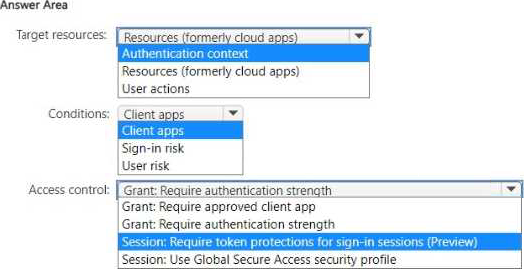
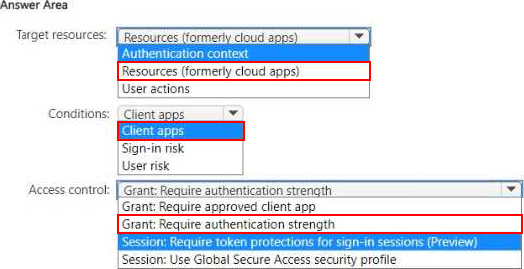
Topic 1, Contoso. Ltd
Case study
This is a case study. Case studies are not timed separately. You can use as much exam time as you would like to complete each case. However, there may be additional case studies and sections on this exam. You must manage your time to ensure that you are able to complete all questions included on this exam in the time provided.
To answer the questions included in a case study, you will need to reference information that is provided in the case study. Case studies might contain exhibits and other resources that provide more information about the scenario that is described in the case study. Each question is independent of the other questions in this case study.
At the end of this case study, a review screen will appear. This screen allows you to review your answers and to make changes before you move to the next section of the exam. After you begin a new section, you cannot return to this section.
To start the case study
To display the first question in this case study, click the Next button. Use the buttons in the left pane to explore the content of the case study before you answer the questions. Clicking these buttons displays information such as business requirements, existing environment, and problem statements. If the case study has an All Information tab, note that the information displayed is identical to the information displayed on the subsequent tabs. When you are ready to answer a question, click the Question button to return to the question.
Overview
Contoso, Ltd. is a law firm that has a main office in Montreal and branch offices in Paris and Seattle. The Seattle branch office opened recently.
Contoso has an Azure subscription and uses Microsoft 365.
Existing Infrastructure. Active Directory
The network contains an on-premises Active Directory domain named contoso.com and an Azure Active Directory (Azure AD) tenant. One of the domain controllers runs as an Azure virtual machine and connects to a virtual network named VNET1. All internal name resolution is provided by DNS server that run on the domain controllers.
The on-premises Active Directory domain contains the organizational units (OUs) shown in the following table.
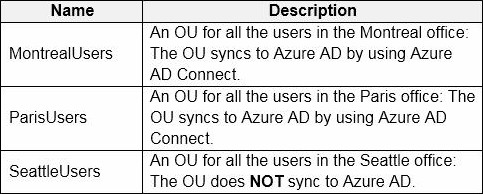
The on-premises Active Directory domain contains the users shown in the following table.

The Azure AD tenant contains the cloud-only users shown in the following table.

Existing Infrastructure. Network Infrastructure
All the Azure virtual networks are peered. The on-premises network connects to the virtual networks.
All servers run Windows Server 2019. All laptops and desktop computers run Windows 10 Enterprise.
Since users often work on confidential documents, all the users use their computer as a client for connecting to Remote Desktop Services (RDS).
In the West US Azure region, you have the storage accounts shown in the following table.

Existing Infrastructure. Remote Desktop Infrastructure
Contoso has a Remote Desktop infrastructure shown in the following table.
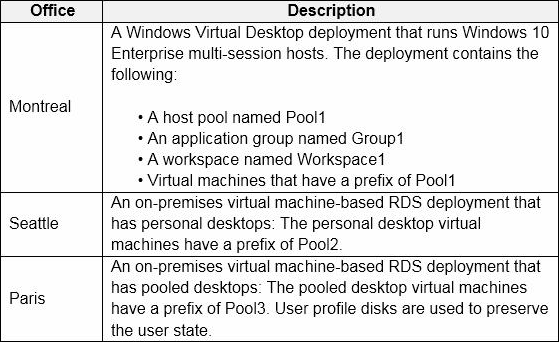
Requirements. Planned Changes
Contoso plans to implement the following changes:
– Implement FSLogix profile containers for the Paris offices.
– Deploy a Windows Virtual Desktop host pool named Pool4.
– Migrate the RDS deployment in the Seattle office to Windows Virtual Desktop in the West US Azure region.
Requirements. Pool4 Configuration
Pool4 will have the following settings:
– Host pool type: Pooled
– Max session limit: 7
– Load balancing algorithm: Depth-first
– mages: Windows 10 Enterprise multi-session
– Virtual machine size: Standard D2s v3
– Name prefix: Pool4
– Number of VMs: 5
– Virtual network: VNET4
Requirements. Technical Requirements
Contoso identifies the following technical requirements:
– Before migrating the RDS deployment in the Seattle office, obtain the recommended deployment configuration based on the current RDS utilization.
– For the Windows Virtual Desktop deployment in the Montreal office, disable audio output in the device redirection settings.
– For the Windows Virtual Desktop deployment in the Seattle office, store the FSLogix profile containers in Azure Storage.
– Enable Operator2 to modify the RDP Properties of the Windows Virtual Desktop deployment in the Montreal office.
– From a server named Server1, convert the user profile clicks to the FSLogix profile containers.
– Ensure that the Pool1 virtual machines only run during business hours.
– Use the principle of least privilege.
DRAG DROP
You need to evaluate the RDS deployment in the Seattle office. The solution must meet the technical requirements.
Which three actions should you perform in sequence? To answer, move the appropriate actions from the list of actions to the answer area and arrange them in the correct order.
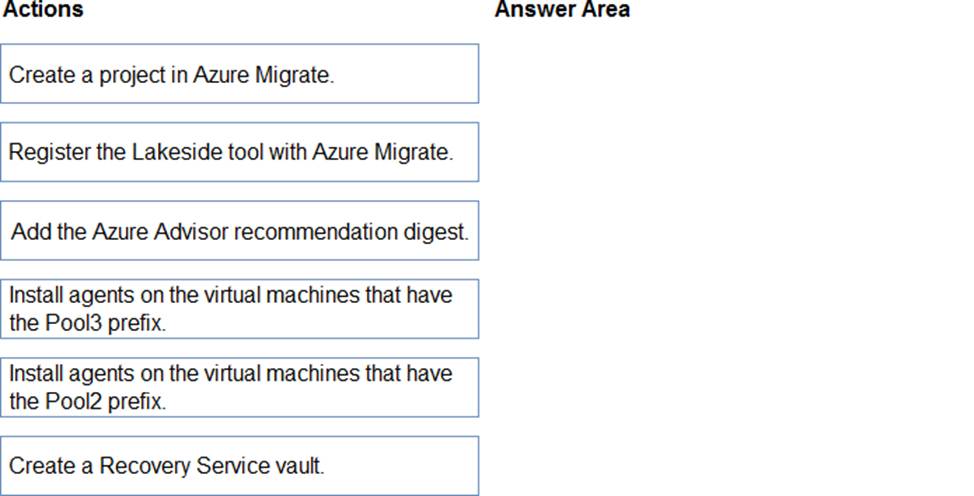
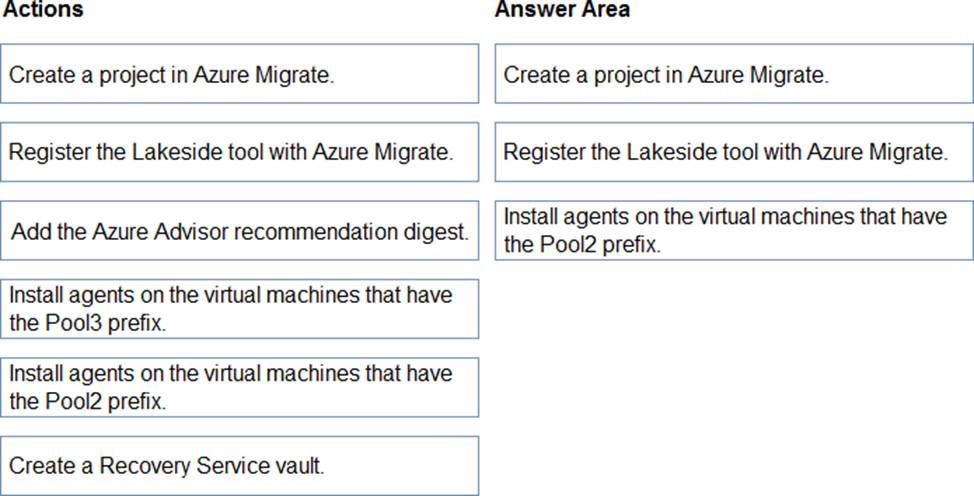
Explanation:
Reference: https://docs.microsoft.com/en-us/azure/cloud-adoption-framework/migrate/azure-best-practices/contoso-migration-rds-to-wvd
HOTSPOT
You have an Azure virtual machine named VM1 that runs Windows 10 Enterprise multi-session.
You plan to add language packs to VM1 and create a custom image of VM1 for a Windows Virtual Desktop host pool.
You need to ensure that modern apps can use the additional language packs when you deploy session hosts by using the custom image.
Which command should you run first? To answer, select the appropriate options in the answer area. NOTE: Each correct selection is worth one point.


Explanation:
Reference:
https://docs.microsoft.com/en-us/troubleshoot/windows-server/deployment/issues-appx-cleanup-maintenance-task
https://docs.microsoft.com/en-us/powershell/module/scheduledtasks/disable-scheduledtask?view=windowsserver2019-ps
You need to modify the custom virtual machine images to meet the deployment requirements.
What should you install?
- A . the RSAT: Remote Desktop Services Tools optional feature
- B . the Azure Virtual Desktop Agent
- C . the Microsoft Monitoring Agent
- D . the FSLogix agent
B,D
Explanation:
Both of these agents are essential for a functioning WVD environment and would need to be installed on the custom virtual machine images.
Which setting should you modify for VNET4 before you can deploy Pool4?
- A . Service endpoints
- B . Address space
- C . DNS servers
- D . Access control (1AM)
- E . Peerings
C
Explanation:
DNS should be configured to use an Active Directory Domain Controller.
HOTSPOT
You have an Azure Virtual Desktop deployment that contains a host pool named HostPool1.
You need to perform the following configurations for HostPool1:
• Set the scale factor of the remote session to 125 percent.
• Generate a registration key that expires after five days.
• Enable Start VM on connect.
Which three settings should you modify? To answer, select the appropriate settings in the answer area. NOTE: Each correct selection is worth one point.
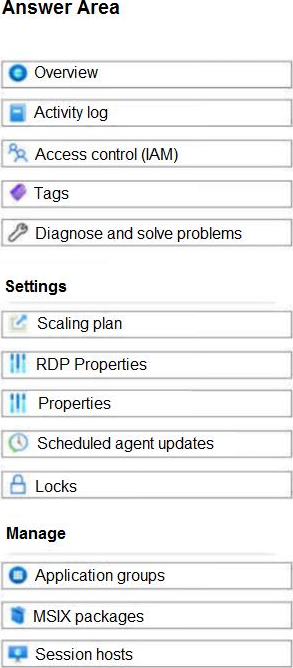
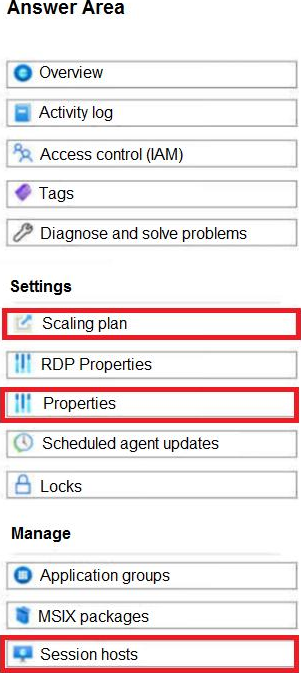
Your company has 60,000 users.
You plan to deploy Azure Virtual Desktop.
You need to recommend a storage solution for the FSLogix profile containers. The solution must provide the highest possible lOPS and the lowest latency desktop experience.
What should you recommend?
- A . Azure Files Standard
- B . Azure Data Lake Storage
- C . Azure Blob storage Premium
- D . Azure NetApp Files
D
Explanation:
Reference: https://docs.microsoft.com/en-us/azure/virtual-desktop/store-fslogix-profile
Which monitoring solution should you configure to meet the security requirements?
- A . VM insights
- B . Azure Virtual Desktop Insights
- C . Application Insights
- D . Azure Monitor activity log insights
